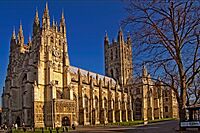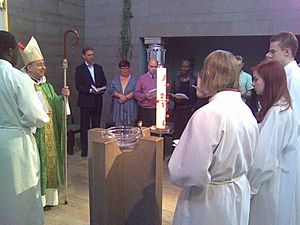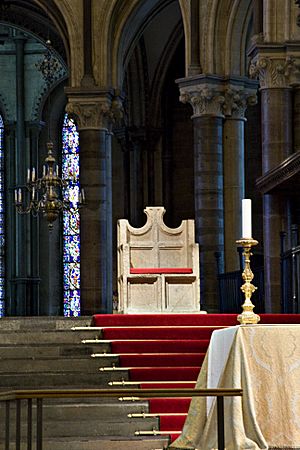Anglican Communion facts for kids
Quick facts for kids Anglican Communion |
|
|---|---|

|
|
| Type | Communion |
| Classification | Protestant |
| Orientation | Anglican |
| Scripture | Protestant Bible |
| Theology | Anglican doctrine |
| Polity | Episcopal |
| Primate | Stephen Cottrell (acting) |
| Secretary General | Anthony Poggo |
| Region | Worldwide |
| Headquarters | London, England |
| Founder | Charles Longley |
| Origin | 1867 Lambeth Conference, London, England |
| Separated from | Roman Catholic Church |
| Branched from | Church of England |
| Separations | Continuing Anglican movement (1977) Some participants in the Anglican realignment (since 2002; partial) |
| Members | 85 - 110 million (2024) |
| Logo |  |
The Anglican Communion is a worldwide family of Christian churches. These churches are connected to the Church of England and share a special bond of "full communion." This means they recognize each other's members and leaders. The archbishop of Canterbury in England is seen as a spiritual leader. He is like the "first among equals" but does not tell other Anglican churches what to do.
With about 85 to 110 million members, the Anglican Communion is one of the largest Christian groups globally. It is usually ranked after the Roman Catholic Church and the Eastern Orthodox Church.
The Anglican Communion officially started in 1867. This happened at a meeting called the Lambeth Conference in London. Charles Longley, who was the Archbishop of Canterbury at the time, led this meeting. Anglican churches believe they are part of the "one, holy, catholic, and apostolic church." Their worship often follows the Book of Common Prayer. Key beliefs are found in documents like the Thirty-nine Articles (from 1571).
Anglican churches have many different beliefs and ways of worshiping. Some are more like Protestant churches, while others are more like Catholic churches. Each national or regional church is independent. They make their own rules and are led by their own bishops. Many members live in countries that were once part of the British Empire. Some churches are called "Anglican," like the Anglican Church of Canada. Others have different names, such as the Episcopal Church in the United States.
Contents
History of Anglicanism
The Anglican Communion grew from the Church of England. The Church of England separated from the Roman Catholic Church in 1534. This happened during the reign of Henry VIII. It briefly reunited in 1555 but separated again in 1570 under Elizabeth I. The Church of England saw itself as a reformed version of the old "English Church."
The oldest Anglican church building outside Britain and Ireland is St Peter's Church in St. George's, Bermuda. It was built in 1612. For a long time, churches in British colonies were part of the Church of England.
How Anglicanism Spread Globally

As the British Empire grew in the 1700s and 1800s, Anglicanism spread with it. At first, the bishop of London oversaw all these churches. After the American Revolution, the churches in the new United States formed their own church. They called it the Episcopal Church in the United States of America. This separation was mostly friendly.
Around the same time, the Church of England started appointing bishops in its colonies. For example, a bishop was sent to Nova Scotia in 1787. More bishops were sent to places like India and Australia. This helped Anglicanism grow worldwide. Over time, these colonial churches became more independent. They started choosing their own bishops and making their own rules.
A very important step was the idea of the Lambeth Conferences. These are meetings where bishops from all over the world come together. The first one was in 1867. These meetings help the churches stay united. They discuss important topics and offer advice. These conferences happen about every ten years.
In 1998, a Lambeth Conference discussed different views on human relationships. For the first time, bishops from Africa, Asia, and Latin America had a stronger voice. This showed a shift in power within the Communion. It meant that growing churches in other parts of the world were becoming more important.
Recent Challenges and Disagreements
In recent years, some churches in wealthier countries have adopted more modern views on certain social issues. This has led to disagreements within the Anglican Communion. For example, some churches have decided to bless same-sex partnerships. This has caused some other churches, especially in Africa and Asia, to disagree strongly.
In February 2023, ten Anglican provinces stated they had "impaired communion" with the Church of England. This means they no longer fully agree with some of its decisions. They also said they no longer recognized Justin Welby, the Archbishop of Canterbury, as "first among equals" in the same way. These disagreements show that while the churches are connected, they are also independent. There is no single authority that can force all churches to agree.
Beliefs and Structure
The Anglican Communion does not have one central legal body that controls all its churches. There is an Anglican Communion Office in London, but it mainly helps with organization. The churches are held together by their shared history and beliefs. They also participate in international meetings.
Three main things keep the Communion together:
- Shared Church Structure: All churches have bishops and a system of church government where decisions are made by groups of leaders. This is called episcopal polity.
- Worship Based on Prayer Books: Worship is often guided by approved prayer books, especially the Book of Common Prayer. This helps ensure that how Anglicans pray shapes what they believe.
- Historical Documents: Important documents and writings from early Anglican thinkers have shaped the Communion's way of thinking.
Early on, Anglicanism developed its own prayer book in English. Unlike some other Christian groups, Anglicans don't have one main leader or a single theologian who defines everything. Instead, the Book of Common Prayer (especially the 1662 version) has been a guide for Anglican beliefs and practices. This means that "the law of praying is the law of believing."
Through history, Anglicans have tried to find a balance between different Christian ideas. They have been clear about what is acceptable within their beliefs. This was set out in the prayer books and the Thirty-nine Articles.
When Anglicanism spread, new ways to stay united were needed. The Lambeth Conferences, started in 1867, were the first big step. These meetings were not meant to take away the independence of local churches. Instead, they were for discussing important matters and offering advice.
The Chicago-Lambeth Quadrilateral
One important agreement from an early Lambeth Conference (1888) was the Chicago-Lambeth Quadrilateral. It set out four key principles for Anglican identity:
- The Bible: The Old and New Testaments contain everything needed for salvation. They are the ultimate guide for faith.
- Creeds: The Apostles' Creed and the Nicene Creed are important statements of Christian faith.
- Sacraments: The two sacraments given by Christ are Baptism and the Eucharist (Holy Communion). These must be done using Christ's words and the elements He chose.
- Historic Bishops: The system of bishops, passed down through history, is important. It can be adapted to fit the needs of different nations.
Ways the Communion Stays Connected

The Anglican Communion has no single legal boss. The archbishop of Canterbury is a spiritual leader, but he doesn't have legal power over other churches. However, four main "instruments of communion" help the churches work together:
- The Archbishop of Canterbury: This person is the spiritual head. All churches in the Communion are connected to him. The office is currently vacant.
- The Lambeth Conference: This is the oldest international meeting, started in 1867. Bishops from all over the world meet to discuss issues and offer guidance. It happens about every ten years.
- The Anglican Consultative Council (ACC): This group started in 1971 and meets every three years. It includes bishops, other clergy, and regular church members from all 38 provinces. It has a permanent office in London.
- The Primates' Meeting: This meeting started in 1979. It brings together the main bishops (primates) from each province for prayer and deep discussion.
These groups help the churches talk to each other and work together. Sometimes, they discuss disagreements, like the different views on LGBTQ+ issues. Some churches have changed their rules to be more accepting, while others strongly disagree. These discussions are ongoing, but there is no way to force a church to change its mind or to kick a church out of the Communion.
Organization of the Anglican Communion
Provinces

| Autonomous churches Episcopal Church of the United States Church in the Province of the West Indies Anglican Church in Central America Anglican Church of South America Anglican Church of Southern Africa Church of the Province of Central Africa Church of the Province of West Africa | Episcopal Church in Jerusalem and the Middle East Church of the Province of the Indian Ocean Anglican Church in Aotearoa, New Zealand and Polynesia Church of the Province of Melanesia Diocese in Europe of the Church of England Extra-provincial to the archbishop of Canterbury Church of the Province of South East Asia No organised Anglican presence |
The Anglican Communion has forty-two independent "provinces." Each province has its own main bishop and way of governing. These provinces can be national churches, like in Canada, or groups of nations, like the West Indies. Most members live in Africa (over 63 million) and Europe (over 23 million).
| Provinces | Territorial Jurisdiction | Membership (active members) | Membership (Self-identified members) | Membership (baptized members) | Year | ||
|---|---|---|---|---|---|---|---|
| Episcopal/Anglican Province of Alexandria | Algeria, Djibouti, Egypt, Ethiopia, Eritrea, Libya, Somalia, Tunisia | 50,000 | 2022 | ||||
| Anglican Church in Aotearoa, New Zealand and Polynesia | New Zealand, Cook Islands, Fiji, Samoa, Tonga | 245,301 | 630,000 | 2010-2023 | |||
| Anglican Church of Australia | Australia | 2,496,273 | 4,865,328 | 2001 - 2021 | |||
| Church of Bangladesh | Bangladesh | 22,600 | 2022 | ||||
| Anglican Episcopal Church of Brazil | Brazil | 19,400 | 120,000 | 2012 | |||
| Province of the Anglican Church of Burundi | Burundi | 900,000 | 2015 | ||||
| Anglican Church of Canada | Canada | 294,931 | 1,134,315 | 2022 | |||
| Church of the Province of Central Africa | Botswana, Malawi, Zambia, Zimbabwe | 900,000 | 2016 | ||||
| Anglican Church in Central America | Costa Rica, El Salvador, Guatemala, Nicaragua, Panama | 35,000 | 126,000 | 2010 - 2022 | |||
| Anglican Church of Chile | Chile | 20,000 | 2010-2018 | ||||
| Province of the Anglican Church of the Congo | Democratic Republic of the Congo, Republic of Congo | 500,000 | 2016 | ||||
| Church of England | England, Crown Dependencies, Europe | 1,019,000 | 9,304,400 | 23,000,000 | 2004-2025 | ||
| Hong Kong Sheng Kung Hui | Hong Kong, Macau | 29,000 | 2004 | ||||
| Church of the Province of the Indian Ocean | Madagascar, Mauritius, Seychelles | 505,000 | 2016 | ||||
| Church of Ireland | Republic of Ireland, Northern Ireland | 343,400 | 2023 | ||||
| Anglican Church in Japan | Japan | 22,000 | 58,000 | 2010-2022 | |||
| Episcopal Church in Jerusalem and the Middle East | Bahrain, Cyprus, Iran, Iraq, Israel, Jordan, Kuwait, Lebanon, Oman, Palestine, Qatar, Saudi Arabia, Syria, United Arab Emirates, Yemen | 39,882 | 2016 | ||||
| Anglican Church of Kenya | Kenya | 5,860,000 | 2017 | ||||
| Anglican Church of Korea | South Korea, North Korea | 65,000 | 80,100 | 2010-2017 | |||
| Anglican Church of Melanesia | New Caledonia, Solomon Islands, Vanuatu | 200,000 | 409,000 | 2016 | |||
| Anglican Church of Mexico | Mexico | 22,000 | 100,000 | 2016 | |||
| Anglican Church of Mozambique and Angola | Angola and Mozambique | 768,200 | 2019-2022 | ||||
| Church of the Province of Myanmar | Myanmar | 62,000 | 2016 | ||||
| Church of Nigeria | Nigeria | 6,897,240 | 22,000,000 | 2010-2016 | |||
| Church of North India | Bhutan, India | 2,200,000 | 2023 | ||||
| Church of Pakistan | Pakistan | 500,000 | 2014 | ||||
| Anglican Church of Papua New Guinea | Papua New Guinea | 233,228 | 2011 | ||||
| Episcopal Church in the Philippines | Philippines | 179,007 | 2020 | ||||
| Anglican Church of Rwanda | Rwanda | 383,904 | 1,240,000 | 2004-2017 | |||
| Scottish Episcopal Church | Scotland | 22,990 | 72,359 | 2022 - 2024 | |||
| Anglican Church of South America | Argentina, Bolivia, Paraguay, Peru, Uruguay | 22,500 | 46,100 | 2010-2023 | |||
| Church of the Province of South East Asia | Brunei, Cambodia, Indonesia, Laos, Malaysia, Nepal, Singapore, Thailand, Vietnam | 98,000 | 168,079 | 2004-2017 | |||
| Church of South India | India, Sri Lanka | 4,500,000 | 2022 | ||||
| Province of the Episcopal Church of South Sudan | South Sudan | 3,500,000 | 2014 | ||||
| Anglican Church of Southern Africa | Eswatini, Lesotho, Namibia, Saint Helena, South Africa | 2,900,000 | 4,000,000 | 2016 | |||
| Province of the Episcopal Church of Sudan | Sudan | 1,000,000 | 2014 | ||||
| Anglican Church of Tanzania | Tanzania | 2,000,000 | 2,685,600 | 3,318,000 | 2010-2017 | ||
| Church of Uganda | Uganda | 13,311,801 | 2024 | ||||
| Episcopal Church | British Virgin Islands, Colombia, Cuba, Dominican Republic, Ecuador, Europe, Guam, Haiti, Honduras, Northern Mariana Islands, Puerto Rico, Taiwan, United States, United States Virgin Islands, Venezuela | 1,547,779 | 2,405,000 | 2016-2023 | |||
| Church in Wales | Wales | 45,759 | 84,000 | 2016 - 2018 | |||
| Church of the Province of West Africa | Cameroon, Cape Verde, Gambia, Ghana, Guinea, Liberia, Senegal, Sierra Leone | 1,000,000 | 2004 | ||||
| Church in the Province of the West Indies | Anguilla, Antigua and Barbuda, Aruba, Bahamas, Barbados, Belize, Cayman Islands, Dominica, Grenada, Guyana, Jamaica, Montserrat, Saba, Saint Barthélemy, Saint Kitts and Nevis, Saint Lucia, Saint Martin, Saint Vincent and the Grenadines, Sint Eustatius, Trinidad and Tobago, Turks and Caicos Islands | 770,000 | 2004 | ||||
| Anglican Communion | Global | 55,599,352 | 66,716,326 | 104,136,209 | 2004-2023 | ||
Churches Connected to Canterbury
Besides the forty-two provinces, there are five other churches directly linked to the archbishop of Canterbury.
| Provinces | Territorial Jurisdiction | Membership (active members) | Membership (Self-identified members) | Membership (baptized members) | Year |
|---|---|---|---|---|---|
| Anglican Church of Bermuda | Bermuda | 9,647 | 14,000 | 2010-2017 | |
| Church of Ceylon | Sri Lanka | 50,000 | 54,200 | 2006-2017 | |
| Parish of the Falkland Islands | Falkland Islands | 810 | 2010-2017 | ||
| Lusitanian Catholic Apostolic Evangelical Church | Portugal | 2,700 | 5,000 | 2010-2017 | |
| Spanish Reformed Episcopal Church | Spain | 5,000 | 11,800 | 2010-2017 | |
Churches in Full Communion with Anglicans
The Anglican Communion churches also have full communion with other Christian groups. These include the Old Catholic churches in Europe and some Lutheran churches. They also have ties with the Malankara Mar Thoma Syrian and Malabar Independent Syrian churches in India. The Philippine Independent Church is also in full communion.
Images for kids
See also
 In Spanish: Comunión anglicana para niños
In Spanish: Comunión anglicana para niños



